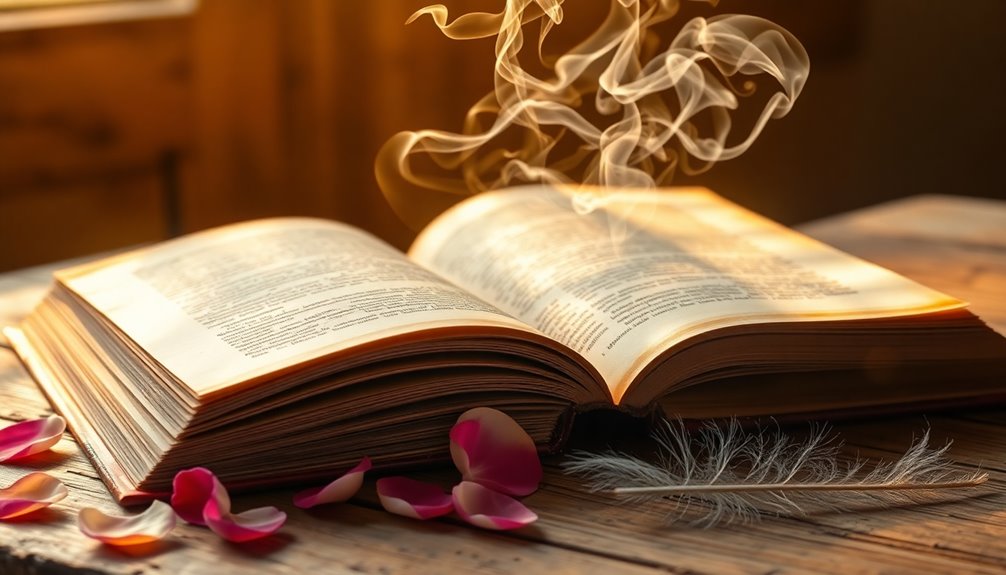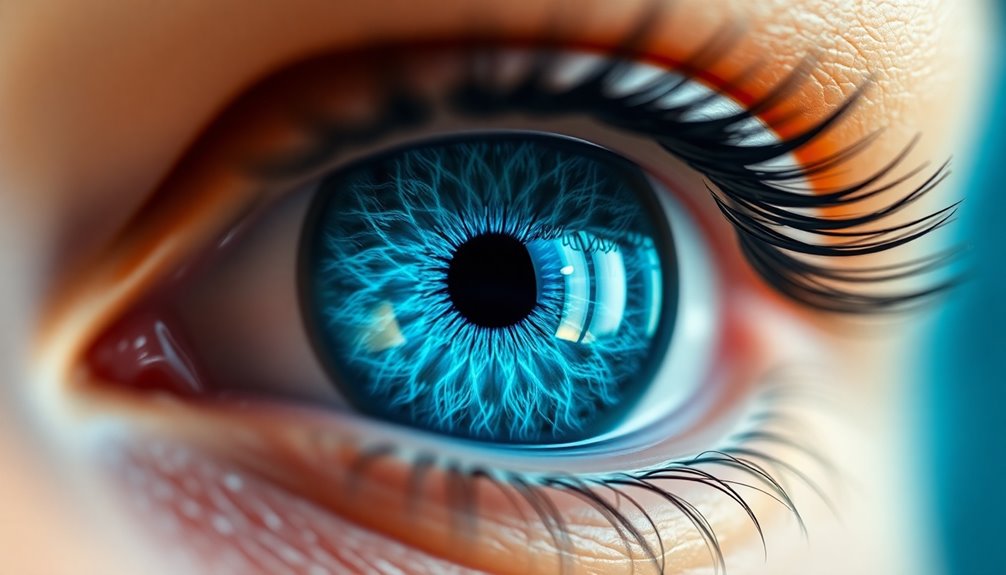Symbolism and imagery aren't the same thing, but they both bring stories to life! Imagery uses descriptive language to create vivid pictures in your mind. It engages your senses, making you feel like you're part of the story. On the other hand, symbolism conveys deeper meanings through objects or events. For example, a heart often symbolizes love. While imagery creates memorable scenes, symbolism adds layers of meaning. Together, they make narratives richer and more enjoyable. By understanding both, you can discover wonderful themes and messages in stories that excite you! Keep exploring to reveal more fascinating connections!
Key Takeaways
- Different Functions: Imagery creates vivid sensory experiences, while symbolism conveys deeper meanings and abstract concepts.
- Nature of Engagement: Imagery engages the senses, whereas symbolism engages intellect and emotions, highlighting their distinct roles in literature.
- Consistency vs. Variability: Imagery provides consistent sensory experiences, while symbolism can vary based on context and cultural interpretation.
- Types: Imagery remains sensory-focused, involving visual, auditory, olfactory, gustatory, and tactile elements, unlike symbolism, which can be universal or internal.
- Interconnectedness: While distinct, imagery and symbolism often work together, enhancing the emotional and thematic depth of a narrative.
Definition of Symbolism

Understanding symbolism is essential for grasping deeper meanings in literature. Symbols are objects, characters, or events that represent ideas beyond their literal sense. For example, a red rose often symbolizes love, while a dove usually represents peace. These symbols are powerful because they allow authors to express complex ideas without saying them outright.
When you read a story, it's important to reflect on the context. The meaning of a symbol can change based on your own experiences and cultural background. What a symbol represents to you might be different for someone else. This makes reading a unique journey for everyone!
Symbolism adds layered meanings to narratives. It enriches the story, making you think more deeply about the characters and events. Instead of just taking things at face value, you can explore the hidden messages. By paying attention to symbols, you'll uncover new insights and enjoy a more rewarding reading experience. Additionally, the use of symbolism in art, such as in urban landscapes, often reflects the socio-political issues of the time, enhancing the viewer's understanding of the cultural context.
Definition of Imagery

Imagery is all about using colorful and descriptive words to paint pictures in your mind. It helps you experience stories through your senses, like seeing, hearing, or even tasting what the characters do. Imagery is often enhanced by the greatest happiness principle, which emphasizes the emotional resonance that vivid descriptions can provide to readers.
Let's explore the different types of imagery and how they make literature come alive!
#
Types of Imagery
Seven distinct types of imagery can transform your reading experience by engaging your senses and creating vivid mental pictures. Imagery uses descriptive language to help you visualize and feel what the author intends.
The first type is visual imagery, which appeals to sight, painting colorful scenes in your mind. Next, auditory imagery engages your sense of hearing, allowing you to listen to sounds that enhance the story.
Then, there's olfactory imagery that brings scents to life, and gustatory imagery that makes you taste delicious flavors. Tactile imagery evokes sensations of touch, making you feel textures and temperatures.
Kinesthetic imagery relates to movement, helping you sense the action happening around you. Finally, organic imagery conveys internal feelings, letting you experience emotions and sensations within.
These types of imagery work together to create rich sensory details that bring stories to life. When you read, you can almost smell the flowers, hear the wind, or feel a character's excitement.
Functions of Imagery
While reading, you mightn't realize how much imagery shapes your experience and connection to the text. Imagery is all about using descriptive language that brings stories to life. It helps you create mental images in your mind, making the scenes feel real. Different types of imagery, like visual imagery and tactile imagery, engage your senses, allowing you to see, hear, and even feel what the characters are experiencing.
When the author uses vivid descriptions, you can imagine the colors of a sunset or the sound of leaves rustling in the wind. Visual imagery paints pictures in your mind, while tactile imagery lets you feel the roughness of a tree bark or the warmth of the sun on your skin. These sensory experiences make the story more exciting and relatable.
Imagery can also deepen your understanding of the narrative. It often works alongside symbolism, adding layers of meaning to what you read. By evoking emotions, imagery creates a bond between you and the text, making every word more impactful.
Examples in Literature
Vivid imagery is essential in literature, as it transports you into the heart of the narrative and allows you to experience the story on a deeper level. Through descriptive language, authors create scenes that you can see, hear, and even feel.
Let's explore some examples in literature that showcase powerful imagery:
- Visual Imagery: In many stories, you might read phrases like "the golden sun dipped below the horizon," painting a beautiful picture in your mind.
- Auditory Imagery: Think of the "whispers of the wind," which can make you feel the mood of a scene.
- Olfactory Imagery: Smells can trigger memories; a fresh-baked pie might remind you of home.
- Gustatory Imagery: The taste of a sweet, juicy peach can bring joy to your palate.
- Tactile Imagery: You can almost feel the roughness of a tree bark or the softness of a kitten's fur.
Through these types of imagery, authors create an emotional connection between you and their literary work.
Examples in literature, like Sylvia Plath's *Metaphors*, show how descriptive language enhances your journey through the text.
Enjoy the vivid world that imagery opens up!
Key Differences

When exploring the key differences between symbolism and imagery, it's vital to recognize how each technique serves distinct purposes in literature.
Imagery creates vivid mental pictures through descriptive language. It engages your senses, appealing to sight, sound, smell, taste, and touch. When you read imagery, you can almost feel the scene come alive!
On the other hand, symbolism conveys deeper meanings through objects or concepts. It often engages your intellect and emotions, suggesting abstract ideas. While imagery adds depth and detail to a story, symbolism attributes specific meanings to elements that mightn't be obvious right away. For example, a dove might symbolize peace, but understanding why requires some thought.
Also, symbolism can be universal, meaning many people recognize its meanings, or internal, which is limited to the story itself.
In contrast, imagery focuses on sensory experiences that are generally consistent across different texts. The context of symbols can change their interpretation, while imagery stays true to its sensory appeal.
Types of Symbolism

Understanding the types of symbolism enriches your appreciation of literature, revealing layers of meaning that mightn't be immediately apparent. By exploring these symbols, you can discover deeper connections in stories you read.
Here are some key types of symbolism to evaluate:
- Internal Symbolism: These symbols are unique to a specific story, like the mockingjay in *The Hunger Games*, representing rebellion and hope.
- Universal Symbolism: These symbols have meanings recognized across cultures, such as the heart for love or a dove for peace.
- Cultural Symbolism: Different societies may interpret symbols in unique ways, highlighting the importance of context in their interpretation.
- Common Symbols in Literature: You'll often see darkness for evil, light for knowledge, and rain for renewal or cleansing.
- Context in Their Interpretation: A symbol like water can mean life or danger, depending on how it's used in the text.
## Types of Imagery

Imagery plays an essential role in literature, employing various techniques to engage the reader's senses and evoke emotions. When we talk about imagery, we're referring to the ways writers paint pictures in our minds. There are types of specific imagery that make stories come alive!
First, visual imagery appeals to your sense of sight. It helps you see characters and settings vividly.
Next is auditory imagery, which brings sounds to life. Imagine the rustling leaves or a child's laughter enhancing the atmosphere!
Then, olfactory imagery invites you to smell scents, like fresh cookies baking or a rainy day. It adds depth to the story, making you feel like you're really there.
Gustatory imagery relates to taste, sparking flavor memories that can remind you of special meals or treats.
Finally, tactile imagery engages your sense of touch. It describes textures, like soft blankets or rough bark, making the narrative feel more real and relatable.
These types of imagery create a rich experience. They invite you on a sensory adventure, making each story more enjoyable and memorable.
Symbolism in Literature

Literature often transcends the surface level of storytelling by embedding symbolism within its narratives. When you read a story, look for the symbols used—it's like finding hidden treasures!
Symbolism in literature allows you to explore deeper meanings that connect with your own life experiences. Here are some exciting ways symbols can enhance your reading:
- Objects: Everyday items can represent big ideas, like a key symbolizing freedom.
- Characters: A hero might symbolize hope, guiding you through the narrative.
- Events: A storm could represent chaos or change, reflecting inner struggles.
- Colors: Bright colors might symbolize joy, while dark colors can signify sadness.
- Animals: Creatures, like the blackbird in Poe's "The Raven," can represent emotions, such as grief.
Imagery in Literature

Creating vivid mental images enhances your reading experience, pulling you deeper into the world of the story. Imagery in literature uses descriptive language that appeals to your senses—sight, sound, smell, taste, and touch. When a writer paints a picture with words, you can almost feel what the characters are feeling.
There are seven types of imagery, but visual imagery often stands out the most. It helps you see the scene in your mind. Think about how Sylvia Plath uses sensory language in her poem *Metaphors*. She creates strong emotional responses, letting you connect deeply with her experience of pregnancy.
Imagery is essential for building mood and atmosphere. It makes the setting come alive, allowing you to immerse yourself in the characters' experiences.
When authors link abstract concepts to tangible experiences through imagery, you gain a better understanding of the themes.
Function in Literary Analysis

Symbolism and imagery each play important roles in literature, and understanding them can make reading even more exciting!
While symbolism uses images to represent big ideas, imagery helps you see, hear, and feel the story come alive.
Distinct Roles in Literature
In countless works, understanding the distinct roles of symbolism and imagery can greatly enhance your literary analysis.
You'll discover that imagery and symbolism each have unique functions. Imagery creates vivid and descriptive mental pictures through sensory details, while symbolism conveys deeper meanings by linking specific objects or actions to abstract concepts.
Here's what to keep in mind:
- Symbolism often represents larger themes, like a heart symbolizing love.
- Imagery enhances your reading experience, evoking feelings, such as joy from a vibrant sunset.
- The repetition of symbols can highlight their importance and stir emotions.
- Varied imagery adds depth and detail to the narrative.
- The interplay between imagery and symbolism can deepen the story's meaning.
Interconnectedness in Analysis
The interplay between imagery and symbolism is essential for a thorough literary analysis. When you immerse yourself in a story, you'll notice how these two elements work together. Imagery creates vivid sensory experiences, while symbolism conveys deeper meanings. By understanding both, you can uncover rich layers within the text.
| Imagery | Symbolism |
|---|---|
| Creates sensory experiences | Conveys deeper meanings |
| Uses descriptive language | Represents abstract ideas |
| Enhances emotional resonance | Highlights significant themes |
When you encounter descriptive language, it helps paint a picture in your mind. This imagery can amplify the impact of symbols, making them more memorable. For example, a red rose might symbolize love. The way the author describes its color and scent adds to that meaning, engaging your senses.
Analyzing both imagery and symbolism encourages you to explore themes and character development. It opens the door to emotional resonance, helping you feel more connected to the story. By recognizing their interconnectedness, you'll enjoy a richer reading experience and develop a deeper understanding of the narrative. So, immerse yourself and discover the magic they create together!
Importance of Understanding

Understanding the difference between symbolism and imagery is essential for anyone looking to enhance their literary analysis skills. By recognizing these two elements, you can dive deeper into the stories you read.
Imagery uses descriptive language to engage your senses and create mental pictures, while symbolism conveys deeper meanings through specific objects or ideas. This understanding enriches your reading experience immensely.
Here are some key reasons why grasping these concepts matters:
- Enhances literary analysis: You'll identify themes and emotional depth more effectively.
- Appreciates the author's intent: It helps you understand what the writer wants to convey.
- Explores character development: You can see how characters change through imagery and symbolism.
- Engages both senses and intellect: You'll enjoy a fuller experience while reading.
- Deepens your insights: You'll uncover layers of meaning in narratives.
Frequently Asked Questions
Can Imagery Be Symbolism?
Absolutely, imagery can be symbolism! When you picture a scene, like a stormy sky, it might represent feelings like sadness or chaos.
That's how imagery adds depth! For example, a wilting flower can symbolize lost hope.
It's all about context. Depending on where it appears in a story, an image can take on special meanings.
Are Symbolism and Imagery Interchangeable?
Think of symbolism and imagery as two colorful crayons in your art box.
They're both important, but they don't do the same thing! Symbolism carries deeper meanings, while imagery paints vivid pictures using your senses.
You can't swap one for the other. When you read, recognizing their differences helps you immerse yourself in the story's emotions and ideas.
What Is an Example of Imagery and Symbolism in a Poem?
Imagery and symbolism can really bring a poem to life! For example, imagine a line describing "the silver moonlight dancing on the waves." That's imagery, creating a beautiful picture in your mind.
Now think about a "broken mirror" in a poem. It might symbolize lost dreams or shattered identity.
Together, these elements make poetry exciting and meaningful! You can see how they work hand in hand, adding depth and emotion to the words.
Is Symbolism Visual Imagery?
No, symbolism isn't the same as visual imagery! Symbolism uses objects or colors to represent big ideas, like a red rose showing love.
On the other hand, visual imagery paints pictures in your mind by using descriptive words. For example, when you read about a "bright yellow sun shining," you can almost see it!
Both devices help tell a story, but they do so in different, exciting ways. Understanding them makes reading even more fun!
Conclusion
To sum up, while symbolism and imagery aren't the same, they both add magic to stories! Did you know that about 70% of readers love books that use rich imagery? This shows how important it is to paint pictures with words. Understanding these tools helps you dive deeper into the tales you read. So, next time you pick up a book, look for those symbols and images; they make the journey even more exciting! Happy reading!











